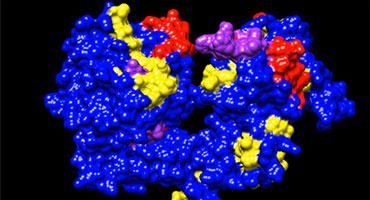Chemistry of Life
Diagnostics and Sensing

Members: Andrew Hudson, Sergey Piletsky, Elena Piletska, James Pickering
Sensor technology development is critical for improving access to point of care diagnostics, the accuracy of disease biomarker detection, and the detection of prohibited substances such as drugs or explosives. Sensor development often relies on the application of frontier technologies in spectroscopy, imaging, photonics and microfluidics. The world-leading research at Leicester seeks to drive innovation in this area through the development of novel sensor platforms and biophysical capabilities.
Molecularly imprinted polymers (MIPS) are a stable and generic form of synthetic molecular receptor that provide an alternative to antibody-based detection technology. Our research has pioneered the development of MIP technology leading to the development of sensors with environmental and clinical applications. A particular focus is on the development of MIP nanoparticles (nano-MIPS) for theranostic applications.
Technological improvements continue to cause a revolution in biophysical capability both at the ensemble level and at the level of individual molecules. In Leicester we have expertise in the development of ground-breaking in situ methods, enabling fluorescence imaging and detection of single molecules with (sub) molecular sensitivity. We have particular expertise in heme sensing and detecting critical events in RNA splicing mechanisms.

Sensors and diagnostic technologies are the backbone of modern life, from healthcare to manufacturing, energy management, and environmental monitoring. In healthcare, sophisticated diagnostics enable crucial early detection of disease, monitoring of vital signs, and improved patient outcomes. In industry, sensors optimize production processes, reducing waste, and improving safety. In transportation, sensors are making autonomous vehicles a reality. Moreover, in the environmental sector, sensors help monitor air quality, track pollution levels, and manage resources more sustainably. In short, sensors and diagnostics are fundamental to innovation, enhancing not just efficiency, but also safety, sustainability, and quality of life on a global scale.